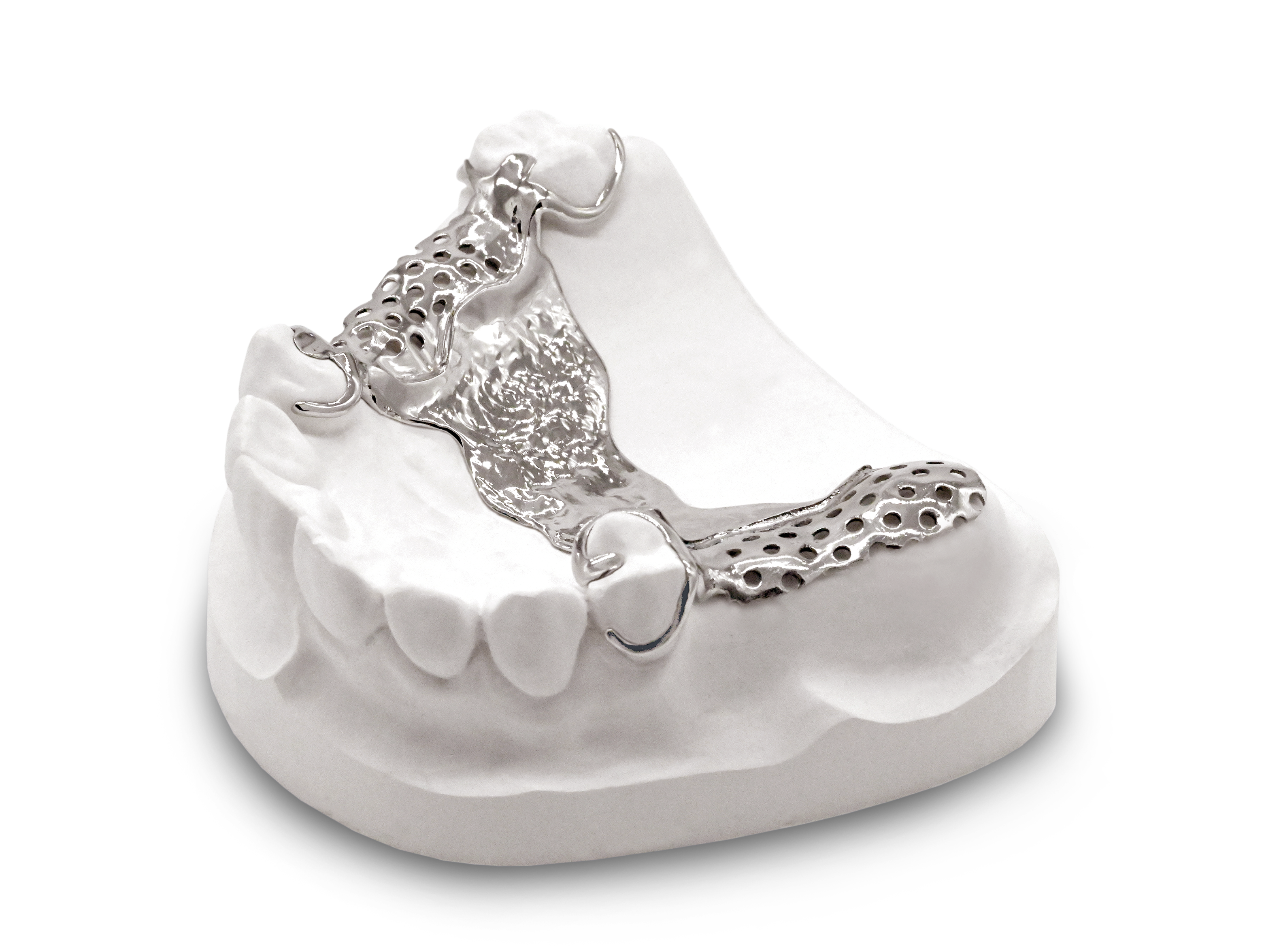Partial framework RPD
The RPD prosthesis with clasps stands for cost-effective patient care with a partial prosthesis, which is taken over as standard care by the statutory health insurance companies.
The RPD prosthesis belongs to the division of removable dentures. Originally, the framework made of non-precious metal (NPM) was cast in the dental laboratory - in a previously created negative form - and thus received its name "model cast" (abbreviated: MoG). The framework is anchored to the natural teeth in the patient's mouth by holding elements such as clasps. The denture saddles with the artificial teeth made of plastic are attached directly to the model cast. The disadvantage is the often visible clasps, which in most cases represent an aesthetically rather unsatisfactory result. As an alternative to clasp prostheses, attachment prostheses, bolt prostheses, telescopic prostheses or implant-supported prostheses are also used.
Indications for partial framework RPD prostheses?
-
Gaps from missing teeth
-
Back teeth are missing
-
The periodontal condition of the remaining teeth is good
-
The patient wants inexpensive, functional restoration
-
Fixed dentures are no longer possible
Contraindications for partial framework RPD prostheses?
-
Poor oral hygiene and tooth decay
-
Wrong area of application, for example front teeth
-
Devitalized, weak remaining teeth
-
Remaining teeth cannot hold the removable denture
-
Poor gum health
The manufacturing
There are now two manufacturing methods in dental technology, and we are going to introduce both of them to you:
Conventional partial framework RPD:
After the impression of the dentition, a master model is produced and articulated with the opposing jaw in an articulator. After measuring the working model with a parallelometer, clasps and frame are drawn in. All undercuts, rests and hollow areas are blocked out with wax. The models prepared in this way are then duplicated with silicone. This creates a hollow shape that is filled with embedding compound. The resulting model is called the embedding model. The markings created in the previous step are now transferred to the new model. The complete partial framework RPD is modeled on the model with the help of wax and precast wax parts. After the sprues have been attached, the embedding compound is again applied to the model. This so-called muffle is then burned out in the furnace and heated up until the partial framework can be poured. After a slow cooling phase, the cast model is divested and then finished and polished.
Digital partial framework RPD:
The model is digitized using a scanner and stored as a patient case in the CAD software. Alternatively, the practitioner can send an intraoral scan to the dental laboratory.
Once the model has been recorded digitally, the design of the partial framework RPD can begin. Here, too, the model is prepared at the beginning and undercut areas are blocked out. As in conventional technology, the partial framework RPD is completely designed on the model.
Now there are two ways to create the partial framework RPD. Either the digital file is printed in burn-out plastic (3D casting) and cast conventionally or the construction is completely digitally implemented using the LaserMelting process (a type of 3D printing in metal).
Whether classic casting or "digital" manufacturing processes - the completion of the partial framework RPD continues to be done in the traditional way.
What are the advantages of a partial framework RPD prosthesis?
-
Simple and inexpensive to manufacture
-
It is considered to be the standard coverage of the health insurance company
-
Slight grinding of the remaining teeth
-
Good stability of the partial framework RPD prosthesis
-
Even distribution of chewing force
-
Restoring the original function
-
Creation of the old face shape
-
Prevents further shifting of the remaining teeth
-
Expandable if the oral situation changes
-
Easy cleaning
What are the disadvantages of a partial framework RPD prosthesis?
-
Damage to natural teeth due to the clasps
-
Acceptance of care in the patient's mouth
-
Feeling of heaviness due to high metal content, for example in the upper jaw
-
Restricted aesthetics due to the clasps in the visible area
The digital partial framework RPD. Is that the future?
Nowadays in particular, there is often a lack of the necessary time or the personnel to carry out such complex and time-consuming work from scratch. It therefore makes sense to outsource work such as partial frameworks RPD with clasps and focus on products and work that can generate higher added value in the ratio of time to remuneration. Of course, the partial framework RPD is also part of the portfolio of every dental laboratory - no question about it - but this is no reason to realize at all costs this work completely in-house.
Here it should be well calculated whether it is not worthwhile to outsource the production step of casting and rework. In almost every case, it is worthwhile to assign these work processes to CADdent® as your manufacturing center.
Even for laboratories that have not yet fully embraced digital dental technology, the scan and construction service offers the same advantages as for colleagues with complete digital equipment.
Some laboratories still regard the production of model casting in the classic process as more sensible and more profitable. In this case, too, CADdent offers the possibility of support via its subsidiary MINDFAB. In this case in the area of rework, which can be automated with the help of a polishing machine. The unique dry polishing process from GPA (DLyte) impresses across the board with its speed, quality and cost savings.
OUR CONCLUSION
Whichever path you prefer and take, with the help of new technologies you can optimize your processes and increase the added value in your laboratory and thus also your profit.
Contact us to find out how you can work together with CADdent® to create more value for your laboratory. Our experts will be pleased to advise you!
